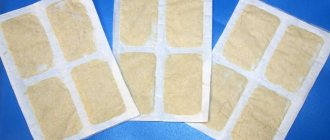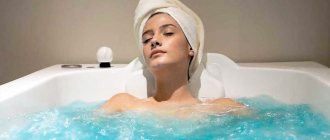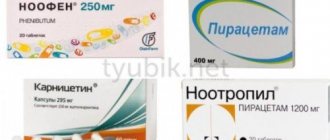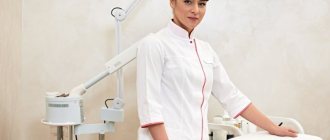SMT physiotherapy or amplipulse therapy is a modern method of physiotherapy that involves influencing biological tissues with sinusoidal currents. Such treatment has a positive effect on the body of a child or adult with a large number of pathologies: from traumatic injuries of soft tissue to osteochondrosis and diseases of the nervous system. It is important to note that this physiotherapy should always be used only as prescribed by the attending physician and as an additional treatment method as part of complex therapy. Otherwise, progression of the underlying disease or development of side effects is possible.
About the method
Amplipulse therapy has a positive effect due to the impact on the body of a pulsed current with a certain frequency - from 5 to 10 kHz. A current with similar indicators easily penetrates the skin and can affect tissues that lie quite deep. Constant modulation of the electric current using the device allows you to create a focus of excitation in the nervous system, which indirectly reduces the intensity of the pain syndrome if it is present. In addition, such an effect causes an increase in the level of endorphins in the brain, which is also manifested by the analgesic effect of SMT therapy, observed in most patients.
Sinusoidal modulated currents in the form of individual impulses affect the contractility of smooth muscle fibers, ensuring the maintenance of their physiological tone. This improves blood circulation in biological tissues and enhances venous and lymphatic outflow, which helps relieve swelling and increases metabolic rate.
SMT therapy should be used as part of a complex effect on the patient’s body, since the procedure is not sufficiently effective as the only method of treatment.
Varieties of pulsed currents also have a positive effect on the state of the hormonal system, primarily on the adrenal glands. These organs play an important role in regulating metabolism and the condition of internal organs in children and adults.
The therapeutic effect of SMT on the body
Amplipulse therapy has the following therapeutic effects:
- Dilates blood vessels and improves tissue trophism.
- Relieves pain and inflammation.
- Reduces spasm of skeletal muscles.
- Improves skin condition, color, tone, elasticity.
- Stimulates the transmission of nerve impulses between neurons, activates the respiratory and vasomotor centers in the medulla oblongata.
- Improves the tone of smooth muscle muscles of organs.
- Normalizes hormone production.
Indications and contraindications
The physiotherapeutic procedure is used in patients with strict adherence to indications and contraindications for use. The main conditions for which SMT therapy is indicated are the following:
- damage to the central and peripheral nervous system in the form of neuralgia, neuropathies, plexitis, radiculitis, etc.;
- traumatic lesions and diseases of the musculoskeletal system, including osteochondrosis, bruises, fractures, sprained tendons in the arms and legs, ankylosing spondylitis;
- diseases of the respiratory system in the form of bronchitis, bronchial asthma and pneumonia;
- pathology of the digestive tract: gastritis, peptic ulcer, biliary dyskinesia;
- disturbances in the functioning of the urinary and reproductive systems (chronic prostatitis, cystitis in remission, erectile dysfunction);
- cardiovascular pathology;
- ophthalmological diseases in the form of dystrophic and inflammatory changes in the eyeball;
- damage to ENT organs, etc.
In addition to the indications, the physiotherapist must identify contraindications to SMT therapy in the patient:
- acute infectious diseases;
- mental disorders leading to inappropriate human behavior;
- decompensated diseases of internal organs;
- damage to the skin at the sites where the electrodes are installed;
- individual intolerance to electrical influence;
- malignant neoplasms;
- history of epileptic seizures;
- changes in the functioning of the blood coagulation system;
- age less than 6 months, and for rectified currents - less than two years;
- pacemaker and other implanted electrical devices;
- bone fractures inside the joint cavity.
If any of the contraindications are present, SMT therapy should be abandoned, since in this case the risks of developing undesirable conditions in the patient significantly increase.
If it is impossible to carry out amplipulse therapy, the patient is recommended to treat concomitant chronic or acute pathologies or use other methods of influencing the body.
Indications for the use of SMT physiotherapy
Amplipulse therapy is widely used in classical medicine and traumatology. The main indications are:
- diseases of the joints and spine (muscle atrophy, arthrosis, osteochondrosis);
- neurological diseases (plexitis, neurosis, depression);
- disturbance of blood circulation and functioning of the venous system;
- gynecological and urological diseases (kidney stones, prostate diseases, infertility, cyst);
- diseases of the digestive system (gastritis, colic, ulcers, constipation);
- diseases of the central nervous system (cerebral palsy, brain injury);
- inflammation after surgery;
- respiratory diseases (bronchitis, asthma).
Amplipulse therapy and its indications and contraindications are wide, but at the same time you cannot thoughtlessly use the devices yourself, without a doctor’s prescription. Only a specialist can determine the optimal exposure time and the number of necessary procedures.
Patient preparation
Special preparation of the patient for amplipulse therapy is not required, however, each person must undergo the necessary minimum examinations:
- The doctor carefully examines the patient’s complaints, which allows not only to establish an accurate diagnosis of the disease, but also to identify concomitant pathologies. It is necessary to clarify information about the presence of a pacemaker or other implanted devices, as well as, if possible, information about the tolerance of electric current.
- All patients undergo a clinical blood test and a general urine test. These research methods make it possible to assess the general state of health and detect hidden inflammatory processes in the body, which are contraindications to physiotherapeutic treatment.
- Electrocardiography and fluorography are aimed at identifying pathologies of the cardiovascular and respiratory systems, which may not manifest pronounced clinical symptoms.
Any data obtained during the examination should be interpreted only by the attending physician with appropriate medical knowledge. If contraindications are identified, therapy can be postponed until they are corrected, or treatment can be carried out using other methods acceptable for use in this patient.
In addition to the examination, the attending physician must discuss with the patient the nature of the upcoming therapy, explain to him its goals and purpose, and the possible risks of developing undesirable consequences.
Devices for SMT therapy and safety precautions
Various devices for carrying out SMT therapy can be used in medical institutions and at home. As a rule, they differ from each other in the number of possible modes, which determines the cost of the device. Most often, Amplipulse devices (3, 5, 7) are used in clinical practice, differing in the specified factor.
When using any devices, you must follow the rules of their operation:
- Before turning on the device for the first time, you must check its integrity, first of all, the housing, electrical plug and electrode wires, and also carefully study the operating instructions.
- Before turning on the device and installing the electrodes on the patient’s skin, you must make sure that the current setting knob is in the “0” position, since otherwise there is a risk of electrical injury.
- The electrodes must be fixed tightly and efficiently using non-conductive materials, such as bandages or elastic bands.
- An SMT therapy session should begin with minimal current levels and constantly asking the patient about his feelings. If there is no tingling or burning sensation under the electrode plates, the current strength is gradually increased until minimal sensations appear. As a rule, during a course of physiotherapy, the current strength increases slightly, which allows for high effectiveness of treatment.
- When using cavity electrodes, the current strength should be set to a minimum level, since the mucous membranes are highly sensitive to such irritation.
It is important to note that self-prescription of amplipulse therapy by the patient and physical therapy at home may lead to progression of the disease or the development of side effects. In this regard, before starting such treatment, the patient should consult with his doctor, who will assess the presence of indications and contraindications for SMT therapy, and also select the necessary parameters of the electric current.
Aftercare treatments
SMT, a physiotherapy procedure, is an effective technique that helps treat numerous diseases, but the maximum effect can be achieved if during the procedure you additionally use medications that will be delivered directly to the site of the disease by the device.
During SMT therapy, the following medications can be introduced into the body through the skin, which prevents the development of undesirable manifestations:
- adrenalin;
- analgin;
- vitamin C;
- vitamin B1;
- gangleron;
- benzohexonium;
- dibazole;
- diphenhydramine;
- ichthyol;
- iodine;
- codeine;
- potassium;
- calcium;
- magnesium;
- novocaine;
- no-shpu;
Before carrying out SMT physiotherapy, it is better not to take No-Shpu - this worsens the therapeutic effect of the procedure - nicotinic acid;
- hydroxybutyrate;
- papaverine;
- proserpine;
- pilocarpine;
- trypsin;
- aminophylline.
In order to cure the disease quickly and without complications, it is better to approach the problem comprehensively. SMT therapy without additional techniques will not be able to completely cure the disease. It is used only as a complementary alternative therapy.
SMT, physiotherapy, is a therapy that is often combined with other techniques:
- Ultrasound. This physiotherapy has a pronounced analgesic, antispasmodic, anti-inflammatory and restorative effect on the body. It can also be carried out using medications to obtain maximum effect.
- Magnetotherapy. This is another method of physiotherapy that affects the body through a magnetic field. The effect is not only on tissue cells, but also on the fluids of the human body.
The procedure helps in the treatment of joints, helps to recover from fractures, and relieves pain. You can undergo the procedure in a hospital or at home by purchasing mobile equipment for yourself.
Carrying out physical therapy
Special preparation of the patient is not required, since amplipulse therapy is a non-invasive treatment method. The patient may sit, lie down, or even stand, depending on the area of intended treatment.
Special electrodes are fixed on the patient’s skin in the area of intended impact. Their sizes are selected depending on the area of contact with the skin. Weights or elastic bandages should be used to secure the plates. Sometimes intracavitary SMT therapy is used. In this case, special electrodes are lubricated with Vaseline and inserted into the desired body cavity, for example, into the vagina or rectum.
Modern medical and home devices for amplipulse therapy have several operating modes, which differ from each other in the frequency of the current and the time of exposure to the human body. The parameters of the procedure should always be set by the attending physician; this can increase its effectiveness and reduce the risk of harm to the patient.
The duration of one session is from 15 to 60 minutes. If this type of physical treatment is performed on a child, the duration of the procedure should be halved. The duration of the course of physiotherapy is up to 10 days. If necessary, SMT therapy can be repeated after a seven-day break.
To obtain the maximum therapeutic effect, amplipulse therapy can be combined with other types of physiotherapeutic treatment, as well as with medications and non-drug approaches.
Dosage:
1) by electric current strength (up to 80 mA); 2) according to the patient’s sensations (painless vibration); 3) by the duration of the procedure (impact on one field up to 10 minutes): during one procedure, impact on no more than 3 fields); 4) according to the frequency of procedures (twice a day with a break of at least 3 hours, daily, every other day); 5) by the number of procedures per course of treatment (up to 10, when exposed to electrical stimulation of muscles up to 20).
The duration of the course, duration of procedures and frequency of treatment can only be determined by a physiotherapist. In Krasnodar, you can receive this procedure at our medical center.
Therapy for osteochondrosis
SMT treatment has proven itself to be an effective method of treating osteochondrosis at various stages of the disease. This method has the following effects on the patient’s body:
- eliminates pain;
- reduces the intensity of the inflammatory process;
- improves blood circulation in the spinal cord and spinal nerve roots;
- increases the rate of regeneration of cartilage tissue in intervertebral discs.
It should be noted that the maximum effect of the procedure is observed if it is used simultaneously with drug therapy and non-drug methods: physical therapy, massage.
To conduct a session for osteochondrosis of the lower back or any other part of the back, the patient lies face down on the couch. Electrodes are installed on the spinal column area, after which the doctor begins a physical procedure. Electrodes can be single, or installed throughout the entire spine.
Osteochondrosis is a chronic disease of the spine, expressed in dystrophic changes in osteochondral structures and leading to a decrease in its functionality. Pathology has become so widespread in the world that it is often not perceived as a serious problem. Discomfort in the lower back or neck does not cause much concern in adults, especially since they go away after taking the pill or on their own. Such a frivolous attitude is the main cause of numerous complications of osteochondrosis, when surgical intervention or long-term therapeutic treatment of the spine is required.
Osteochondrosis used to occur in adults, usually after 35–40 years, but nowadays people of young and adolescent age turn to doctors. Timely detection of pathology and the prescription of competent treatment is a guarantee of successful restoration of the functions of the musculoskeletal system and prevention of further development of degenerative processes in spine .
Types of disease
With osteochondrosis of the spine, the pathological process involves the vertebrae, fibrous ring, intervertebral discs , neurovascular bundles, muscles and tendons. Depending on which department has undergone changes, the classification of osteochondrosis is as follows:
- cervical;
- chest;
- thoracolumbar;
- lumbar;
- lumbosacral.
The disease manifests itself in a variety of symptoms, the severity of which depends on the force of compression of the nerves in the intervertebral foramina, as well as the intensity of the inflammatory process. The most unpleasant and, unfortunately, common complication is rupture of the fibrous ring, which leads to prolapse of the nucleus pulposus, compression of nerve endings, blood vessels, and in severe cases, the spinal cord.
Symptoms
The main symptoms of osteochondrosis are pain, discomfort, stiffness, and numbness in the affected area. The pain can be sharp, shooting, aching, sudden or constant. Very often, painful sensations spread to other parts of the body - they radiate to the lumbar region , arm, leg, shoulder, head. It all depends on the degree of damage to the spine and the localization of the pathological process.
Cervical osteochondrosis leads to constant headaches, and when the thoracic region is affected, the same symptoms are observed as with heart disease: a feeling of heat in the chest area, difficulty in inhaling, shooting pain under the scapula, in the shoulder joint. With lumbar osteochondrosis, there is often a feeling of tingling or numbness in the legs. Over time, a person’s posture changes, muscles and ligaments lose elasticity, blood circulation worsens, and congestion develops in the tissues.
Diagnosis and treatment
The main methods for diagnosing osteochondrosis are radiography of the spine, magnetic resonance imaging (MRI), computed tomography (CT). Based on hardware tests, the doctor makes a diagnosis and draws up an individual treatment plan.
Treatment programs imply an integrated approach, using medications (eliminate inflammation), physiotherapeutic methods, and physical therapy. Surgeries are indicated in cases where there is a threat of serious complications, in the absence of effectiveness of conservative regimens.
Types of physiotherapy for osteochondrosis
Physiotherapy is a list of techniques based on the effects of natural or artificially created medicinal substances and physical factors on the human body. During physiotherapy, various types of medical equipment with a certain type of impact are used. The main goals of physiotherapy for osteochondrosis are eliminating pain, stimulating microcirculation and tissue regeneration, suppressing the inflammatory process, relieving muscle tone and spasms, and normalizing metabolic processes.
The main methods of physiotherapy used in the complex treatment of osteochondrosis include:
- electrotherapy (electrophoresis, diadynamometry, amplipulse therapy);
- magnetic therapy;
- laser therapy;
- ultraphonophoresis;
- amplipulse therapy.
Many methods of physiotherapy for osteochondrosis are prescribed only when positive dynamics are established, after completing a course of drug treatment, or in a stable condition, when exacerbations are not observed for a long time. But there are other methods that are prescribed in the acute period: for example, magnetic therapy, laser treatment, short-pulse electroanalgesia. The type of physiotherapy is chosen by the doctor, taking into account the characteristics of the disease, age, localization of the pathology, and the presence of relative contraindications.
Electrophoresis is one of the oldest methods of physiotherapy , which involves the introduction of drugs under the skin under the influence of a weak current. This method is most often used for cervical osteochondrosis . Charged particles penetrate the area of inflammation and accumulate there, providing a therapeutic effect. The duration of action of medications reaches 12–15 hours, which is the basis for achieving a high therapeutic effect. As a rule, doctors add massage, mud applications, turpentine baths and other procedures to electrophoresis.
Magnetic therapy is the effect of a magnetic field on the affected area. In physiotherapy , low-frequency, high-frequency, alternating, and pulsed magnetic fields are used. Treatment is used for osteochondrosis of all parts of the spine . The intensity and time of exposure to the field is set by the doctor using a special device (device). This type of physiotherapy allows you to normalize lymph flow, eliminate pain by blocking nerve fibers, improve the rheological properties of blood, enhance the effect of other types of treatment, and also eliminate muscle spasms.
Amplipulse therapy is a method of physiotherapy based on the use of alternating sinusoidal currents with a given frequency. Amplipulse helps eliminate swelling in inflamed tissues, relieve pain, and improve blood circulation. It has been proven that the use of the technique has a beneficial effect on the functioning of the peripheral nervous system. For physiotherapeutic treatment of osteochondrosis of the cervical spine , currents with a frequency of 80–100 Hz are used; for the thoracic region and lower back, parameters are set from 30 to 50 Hz. The procedure is carried out daily or every other day, at least ten times.
Ultrasound therapy is a method of physiotherapeutic treatment based on the effect of ultrasound radiation on cartilage tissue, muscles and bone structures. To carry out the procedure, a special device with a software package is used, where the parameters of the ultrasonic flow are set. The inclusion of physiotherapy in the treatment complex gives excellent results in the treatment of lumbar cervical osteochondrosis and other types of the disease. After a course of procedures, microcirculation is activated, swelling is reduced, the inflammatory process is softened, and muscle spasms are relieved.
Galvanization is the application of continuous low voltage electric current to the affected area. The energy penetrating into the body triggers complex physical and chemical processes, as a result of which metabolism is activated, muscles relax, and the intensity of inflammation in the lumbar, thoracolumbar, and cervical spine . The course of treatment consists of 12–14 procedures, the duration of which varies from 20 to 40 minutes.
Ultraphonophoresis is a physiotherapeutic treatment of osteochondrosis using medications administered through the skin into tissues using ultrasound energy. After a course of sessions, stabilization of the nervous system, increased elasticity of cartilage and muscle tissue, and a pronounced analgesic effect that is maintained for a long time are observed. As after other physiotherapeutic procedures , blood circulation is encouraged and tissue nutrition is improved.
Laser therapy is the treatment of the spine using laser radiation that is converted into thermal energy. This progressive method of physiotherapy has a number of valuable advantages - it:
- has a targeted effect (the laser beam does not affect healthy tissue, but acts within a given segment);
- triggers the regeneration mechanism of new cells, activates metabolic processes;
- activates blood flow, improves microcirculation;
- gently and deeply warms tissues;
- eliminates radicular syndrome;
- lasts a short time (10 minutes);
- strengthens the body's immune forces;
- increases the absorption of drugs.
Contraindications to laser treatment of osteochondrosis are diseases of the hematopoietic organs, cancer, post-stroke and post-infarction conditions, dermatoses in the area of exposure and some other conditions.
Advantages of treating osteochondrosis at the Profmedcenter clinic
The Profmedcenter clinic has the latest medical devices used in physiotherapy for the treatment of osteochondrosis . Our specialists will quickly conduct an examination, make the correct diagnosis and prescribe treatment according to an individual program. Experienced doctors with successful professional experience carefully select therapeutic regimens, taking into account the age of the patients, the nature of the pathology, and the expected effects of conservative treatment.
Patients will not have to stand in line for an appointment with a specialist, a diagnostic examination or a physical therapy . We value the time of our clients and staff, so we do not allow any downtime. Attentiveness, friendliness, provision of information of interest in an understandable form are the priorities of our clinic. If you have any questions, call +7 (473) 202–2–602 during business hours.
Possible complications
SMT therapy is a safe treatment method and can be performed even during pregnancy. However, in some situations, against the background of such a physical procedure, the patient may experience undesirable conditions. Most often complications develop for the following reasons:
- improper use of the SMT therapy device;
- carrying out a physiotherapeutic procedure if the patient has contraindications to it;
- using SMT therapy in conjunction with medications, when side effects from the medications themselves are possible;
- intolerance to electric current in a sick person, not identified before treatment.
Such reasons can become factors in the development of the following complications of amplipulse therapy:
- redness and damage to the skin in the area where the electrodes are installed;
- progression of the underlying disease;
- allergic reactions to electrical influence;
- negative changes in the functioning of internal organs.
If any complications develop, as well as unpleasant sensations appear during amplipulse therapy, the doctor must immediately stop treatment and refer the patient for additional examination to identify the causes of the appearance of clinical symptoms.
What are the stages of this disease, and how do they differ?
Like any disease, osteochondrosis goes through several stages in its course, at each of which its own treatment methods are recommended. There are four such stages in total:
- The first is practically asymptomatic, but destructive processes already begin inside the spinal discs, and the spine itself becomes more susceptible to injury.
- The second is characterized by more pronounced disorders, which are revealed during examination. During this period, the intervertebral spaces narrow.
- The third is characterized by the appearance of obvious deformation, determined visually, and even a hernia. Pain syndrome may also occur. At this stage, the patient often seeks medical help himself with complaints of pain with sudden movements. Symptoms depend on the location of the diseased area.
- The fourth stage is the most difficult. As a result of pinched nerve endings, the patient experiences severe pain, which can lead to complete immobilization.
To avoid the occurrence of intervertebral hernia, treatment of osteochondrosis should begin as early as possible, at the first signs of disruption of the proper functioning of the spine, without waiting for the manifestation of severe pain.
Advantages of the method
CMT therapy has significant advantages over other treatment methods. Among them, it is worth highlighting the following factors:
- Even the first procedure benefits the patient, leading to a decrease in the severity of symptoms of the disease. This occurs due to the direct effect of alternating electric current on the pathological focus and nerve formations.
- This type of physiotherapy has a high level of safety due to the use of low-intensity currents. This makes it possible to treat diseases using SMT physiotherapy in patients of any age, including the elderly.
- Amplipulse therapy has a positive effect in a large number of diseases - from gynecological problems to back pain, which makes it possible to recommend this method to a large number of patients.
- The use of intracavitary electrodes provides a more accurate impact on the lesion in diseases of the pelvic organs.
Such advantages of SMT treatment determine the prevalence of physiotherapy and the possibility of its implementation in any medical institutions. It is also carried out at home, which is especially important for the treatment of diseases in childhood.
Effects
CMT physiotherapy affects nerve and muscle fibers. The muscles become excited and contract, which is felt as twitching or vibration. Peripheral nerves are blocked, realizing the analgesic effect. Receptors of internal organs and skin are involved in the stimulation process. All this leads to:
- increasing trophism, activating microcirculation, reducing swelling;
- stimulation of reparative processes;
- reduction of inflammatory manifestations and pain;
- improvement of muscle tone;
- increased activity of the intestines, biliary tract, bladder and ureters.
SMT therapy in children
A child’s body has less adaptive capabilities than an adult’s, which must be taken into account when prescribing physiotherapeutic treatment. Such therapy in children has the following features:
- amplipulse therapy should not be used in children under six months of age;
- rectified currents are recommended for use over the age of two years, as they have a pronounced irritating effect on the body;
- the general principles of treatment are similar to those for adults, however, the duration of one treatment session should be reduced by 2-3 times;
- you should use special “children’s” electrodes, which differ from “adult” ones in their size;
- the electrode plates should be tightly fixed with bandages, since children rarely maintain a motionless body position for a long time;
- During the physical procedure and after it, it is necessary to constantly contact the child and find out from him about the sensations and discomfort experienced, this allows you to timely identify the development of side effects and determine the effectiveness of treatment.
CMT therapy can treat a large number of pediatric diseases. However, it is important to remember that the child’s body is more susceptible to the development of complications, and therefore, during physical treatment, the child must be constantly monitored by a pediatrician in the form of periodic consultations.
Physiotherapy occupies an important place in the treatment of diseases of internal organs, making it possible to improve the effect of using medications. SMT, or amplipulse therapy, is a modern method of influencing the body, carried out by a sinusoidal current, which has a complex effect on biological tissues. SMT procedures have an analgesic and anti-inflammatory effect, improve regeneration, accelerate metabolism and blood circulation in the affected area. This treatment can be used in patients of any age - from young children to the elderly, which is associated with the high level of safety of such therapy.
Device "Amplipulse": operating principle of the device
The Amplipulse device is used in medical institutions, beauty salons, or at home by patients themselves. The device generates four types of currents (with continuous and intermittent effects) and acts in alternating current mode of different polarities.
The installed microcontroller generates the currents; it also provides a smooth rise and fall. The voltage generated in this way goes to the current amplifier, and then to the transformer and connector of the device. The type of impact is set on a special mode switch. Now there are several types of these devices on sale, depending on the date of release. The latter of them have additional functions and smaller dimensions.






